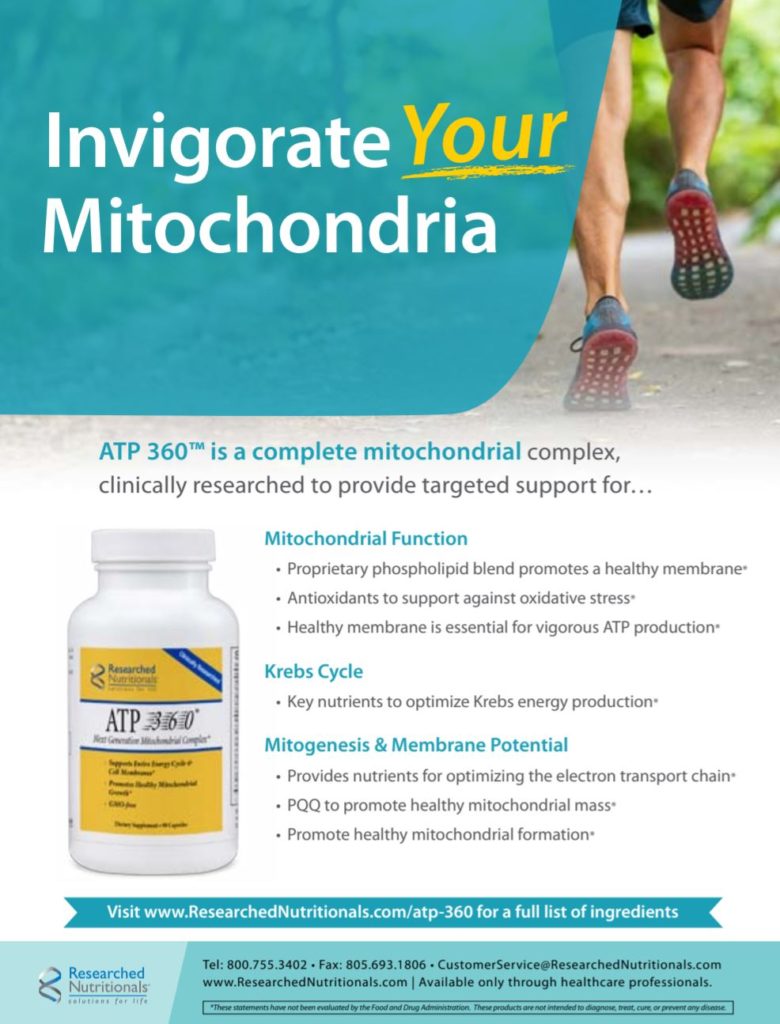By Chris D. Meletis, ND
Despite ongoing discussions about potential treatments for COVID-19, there has been little talk of the role that the mitochondria may play in supporting the health of patients with this disease as well as in proactively bolstering our immune systems. Yet, there is some recognition in the medical literature that SARS-CoV-2, the virus that causes COVID-19, may escape innate immune surveillance through causing changes in the mitochondria.1 In this article, we will discuss the role that the mitochondria play in immunity, the possible effect of SARS-CoV-2 virus on the mitochondria, and the potential role of NAD+ and its most efficient precursor nicotinamide riboside on immune health in people exposed to the SARS-CoV-2 virus.
An NAD+ precursor that supports mitochondrial
function could potentially inhibit SARS-CoV-2.
Mitochondria’s Role in Immunity
Mitochondria are important organelles in the cell. They are essentially the cells’ batteries, as they are responsible for the production of ATP, the body’s cellular fuel. Mitochondrial DNA promotes innate immunity,2 the type of immunity that serves as the first line of defense against viral, bacterial, and other pathogens. When mitochondrial DNA (mtDNA) is released from the mitochondria, this stimulates immune responses.2 Within cells, there are systems in place to detect the DNA of invading pathogens. Cyclic GMP‐AMP synthase (cGAS) and stimulator of interferon genes (STING) both play an important role in the cell’s detection of pathogens.2
Mitochondrial DNA released from the mitochondria into the cytoplasm of the cell (the part of the cell outside the nucleus) can activate cGAS and STING, thus helping cells to identify invaders and promote viral resistance.3,4 Additionally, cells that exhibit mitochondrial DNA stress and release mtDNA into the cytoplasm are more resistant to infection with herpes simplex virus‐1 (HSV‐1) or vesicular stomatitis virus (VSV).2 SARS-CoV-2, however, is an RNA virus. Yet, even though cGAS, which detects the presence of viruses, is specific for DNA, RNA viruses such as the dengue virus can elicit a cGAS‐STING response.5 Studies have found that the dengue virus can trigger the release of predominantly oxidized mtDNA into the cytosol of the cell, where it activates the viral detector cGAS.6 However, the dengue virus has evolved to bypass this mitochondrial strategy of the cell to signal a viral infection, which leads to the persistence of the virus.7 It is interesting to note that in addition to DNA, mitochondria also contain dsRNA, which promotes a strong immune response.2
We do not know at this point how SARS-CoV-2 will respond to mtDNA release into the cytosol of the cell and the subsequent cGAS signal to the body that a virus is present. We do know that a number of viruses target the mitochondria in order to proliferate throughout cells in the body. The influenza A viral protein PB1-F2, which is involved in the virulence of this viral infection, targets mitochondria, resulting in mitochondrial fragmentation and impaired innate immunity.8
A number of viruses cause mitochondrial fusion, which is required for the virus to spread throughout cells of the body and help the virus evade innate antiviral responses.9 Severe acute respiratory syndrome coronavirus (SARS-CoV) contains a virulence factor called ORF-9b, which can trigger mitochondrial fusion.10 This eventually inhibits host cells from producing interferon (IFN).10 IFN is important in an immune response against the virus and induction of interferon inhibits viral replication. Additionally, a viral protein from HIV can also lead to mitochondrial hyperfusion.11
One group of researchers suggested that “Since many of the viral proteins that target mitochondria are essential for viral replication, they might serve as critical drug targets for generating therapeutics against viral infections.”9
Different viruses target different aspects of mitochondrial metabolism, including β-oxidation and the citric acid cycle (TCA Cycle or Krebs Cycle).9 Some viruses such as influenza A and HIV can disrupt mitochondrial function to cause cell death9 whereas others such as dengue, Zika, and chikungunya promote viral replication and dissemination by inhibiting cell death.12-14
What SARS-CoV Does to the Mitochondria
The virus that causes severe acute respiratory syndrome (SARS) is known as SARS-CoV. It was discovered in Asia in 2003. We can get an idea how its viral successor, SARS-CoV-2, which causes COVID-19, affects the mitochondria by looking at the behavior of SARS-CoV.
SARS-CoV can effectively hide from the body’s innate immune surveillance. As mentioned earlier in this article, a protein encoded by SARS-CoV called open reading frame-9b (ORF-9b) localizes to the mitochondria, where it causes mitochondrial hyperfusion.10 This facilitates viral replication by targeting a mitochondrial protein that’s involved in an antiviral response.10 This in turn stops the host cell from making enough IFN as well as NF-κB and IL-6,15 which are other substances that normally signal the immune system that there is a problem that needs to be addressed. This may encourage viral replication in the beginning stages of infection while the virus works behind the back of the immune system.10,15 In fact, IL-6 levels are not significantly enhanced until the fourth day after human lung epithelial cells are infected with SARS-CoV.16
The Role of NAD+ in the Mitochondria and Immunity

Nicotinamide adenine dinucleotide (NAD+) is an essential coenzyme required for healthy metabolism and energy production in each of our cells. It is the primary electron donor in the mitochondrial respiratory chain.17 Increased NAD+ levels are linked to increased sirtuin activity, especially SIRT1 and SIRT3.17 Sirtuins are proteins that are essential for cellular health and play a role in increased longevity. In fact, sirtuins need NAD+ to function. The body also needs SIRT1 and SIRT3 for mitochondrial biogenesis,17 andNAD-consuming sirtuins are involved in the innate immune response.18
NAD+ is involved in immunity and it has been shown to regulate the function of macrophages, immune cells that act as the first defense against pathogens.19 Increasing levels of NAD+ production in immune-compromised or aged macrophages restored immune responses.19 This led one group of researchers to conclude, “Breakdown of de novo NAD+ synthesis may underlie declining NAD+ levels and rising innate immune dysfunction in aging and age-associated diseases.”19
There are a number of other indications NAD+ plays an important role in immunity. Without NAD+ we could not make ATP, which is essential for immune function.20 In addition, viral infections disrupt NAD+ homeostasis and deplete NAD+ levels.21 Recently, researchers investigated SARS-CoV-2 infection of cell lines, infected ferrets, and a deceased patient’s lung.21 They found that SARS-CoV-2 “consistently and strikingly” impaired the NAD+ gene set in regards to the production and use of NAD+. SARS-CoV-2 triggers a set of poly(ADP-ribose) polymerase (PARP) family members, including enzymes required for innate immune response. Overexpression of a virally induced PARP (PARP10) suppresses host cell NAD+ metabolism.21 Research indicates that increasing NAD+ levels through the nicotinamide and nicotinamide riboside kinase pathways may restore antiviral PARP functions, thereby supporting innate immunity to SARS-CoV-2.21 The fatigue commonly associated with COVID-19 is likely in part due to NAD+ depletion and mitochondrial impact, along with alterations of sirtuins and PARPs activity.
We also lose up to about 50% of our NAD+ levels between the ages of 40 and 60,22 and NAD+ levels are also low in diabetics and during obesity,22 underlying conditions that predispose to a worse outcome in COVID-19. It is of note that the SARS-CoV-2 virus takes a greater toll on the elderly.







